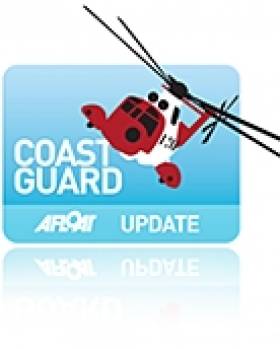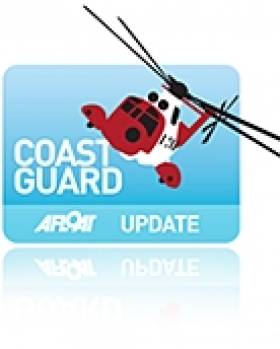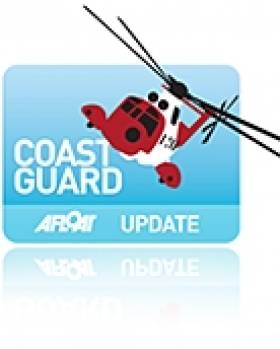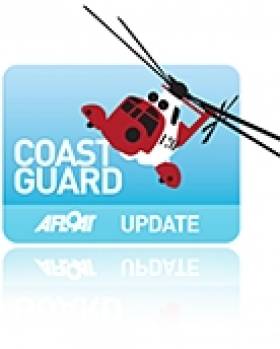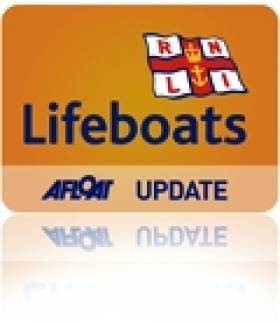Displaying items by tag: Irish Coast Guard
Tit Bonhomme Inquest Criticises 999 Service
#TitBonhomme - The "extraordinary" lack of information solicited by the operator who took the first of two emergency calls from the sinking Tit Bonhomme has been taken to task at the inquest into the loss of the trawler's crew.
The Irish Times reports that it only emerged last week that two emergency calls were made from the vessel by its youngest crew member Kevin Kershaw, though the Irish Coast Guard and the Marine Casualty Investigation Board (MCIB) were previously aware of only one.
The first - and previously unreported - 999 call from Kershaw's mobile phone at 5.46am was transferred to Bandon Garda Station rather than to the coastguard. Barrister Elizabeth O'Connel, representing the widow of skipper Michael Hayes, described the dearth of details taken by the operator on that call as "extraordinary".
It was only on the second call placed three minutes later that the Irish Guard was notified of the incident by 5.53am.
The Department of Communications has since announced it will conduct a review of the 999 service provided by the Emergency Call Answering Service (Ecas), operated by BT Ireland from Ballyshannon, Navan and Dublin.
As previously reported on Afloat.ie, five fishermen lost their lives when the trawler Tit Bonhomme went down after striking rocks at the mouth of Glandore Harbour.
The only survivor, Abdelbaky Mohamed, gave testimony to the inquest two weeks ago of his last moments aboard the stricken vessel.
#Coastguard - The Irish Coast Guard has issued advice to the public for the June bank holiday weekend regarding safety on the water and when enjoying leisure activities on cliff paths and walks.
Bright and dry weather with sunny spells is forecast over the weekend with highest temperatures of 13-18 degrees. The current spell of good weather is forecasted to last over the weekend when traditionally many people take to the water and enjoy outdoor bank holiday activities.
Irish Coast Guard manager Declan Geoghegan said: “Warmer weather encourages everyone to enjoy the outdoors but we are appealing to the public to be aware of safety when on the water, enjoying our coastline and walking on cliffs and other areas.
"This summer, we began our 2013 safety awareness campaign in May and our campaign this year is aimed at holidaymakers, those engaged in water sports, people enjoying cliff walks or engaging in coastal activities throughout Ireland. We are also targeting walkers and climbers.
“In the last week alone, we have had at least three incidents with swimmers getting into difficulty around the country. Unfortunately one person lost their life.”
Throughout the summer (as at other times of the year), coastguard units throughout the Ireland will patrol our rivers, lakes, waterways and coastlines issuing safety advice and information to holidaymakers and tourists.
The following are general safety tips and advice from the Irish Coast Guard to help enjoy the water and coastal activities in your area this weekend and this bank holiday weekend and throughout the summer:
Swimming
Only swim at beaches and waterways that have lifeguards on duty and pay attention to the safety flags. Ask the lifeguard for advice about safety and water conditions and adhere to their instructions. Avoid using inflatable toys such as lilos and rubber rings on the water.
Cliff Walking
There is safety in numbers, so never be alone if possible. Let somebody know when and where you are going and what time you will be back. Stay well away from the cliff edge, both top and bottom. Don’t attempt to rescue people or pets if they fall over the edge. If assistance is required dial 999/112 and ask for the coastguard.
Watersports & Coastal Activities
Before going to sea check local weather conditions and tides in the area. Wear correctly maintained and fitting lifejackets that are suitable for the activity. Lifejackets are of no use unless they are worn. Ensure your craft is fit for purpose. Always advise someone as to where you are going and the time of your intended return. Do not overload the craft. If you are in difficulty or see someone in difficulty and requiring assistance dial 999/112 and ask for the coastguard.
For specific advice and information on any water and coastal activity visit www.safetyonthewater.ie.
#Coastguard - The Irish Coast Guard may lead open-sea searches for American space bosses when manned space flights resume, according to the Irish Examiner.
Coastguard chiefs have reportedly been in informal discussions with a senior official from Nasa regarding search and rescue procedures should a manned capsule come down in the North Atlantic.
Nasa's planned launch trajectory for rockets to the ISS or the moon, scheduled to resume in 2016, passes the south coast of Ireland within range of the new Shannon-based helicopter Rescue 115.
This means that if a Nasa vehicle were to ditch in those waters, the Irish Coast Guard would take the lead in any search and rescue effort.
The Irish Examiner has much more on the story HERE.
Howth Coast Guard Trains With Irish Red Cross
#Coastguard - Howth Coast Guard has blogged about its recent medical exercise with the Irish Red Cross.
The multi-casualty medical training exercise involved lowering a number of qualified and trainee emergency medical technicians (EMTs) into Whitewater Brook by the heights rescue team.
These EMTs served as serious trauma victims who were then retrieved through the joint effort of over 40 personnel between the two organisations who worked together to triage, treat and evacuate.
Another recent training exercise, as featured in the video above, involved the safe evacuation of a casualty with a lower limb fracture.
"One of the more common callouts we receive are for people enjoying walking or running in the area who slip and fracture a lower limb or ankle injury," said the North Dublin-based unit of the Irish Coast Guard.
"The team regularly train for this scenario, ensuring all members are able to stabilise, package, and evacuate by stretcher a casualty in this situation."
Aran Islands RNLI Rescue Fishermen in Galway Bay
#RNLI - Aran Islands RNLI in Galway Bay assisted six fishermen from a 24m trawler yesterday Thursday 18 April.
The volunteer lifeboat crew launched their all-weather lifeboat at 4.20pm following a report that a fishing vessel, the Archangel, with six crew on board had got into difficulty and broken down one mile north west of Inishmore.
There was a six-metre swell at the time with a force seven to eight wind.
The lifeboat crew under coxswain John O’Donnell arrived on scene accompanied in the air by Irish Coast Guard helicopter Rescue 115 - the subject of its own documentary TV series currently showing on RTÉ One - and established a tow line removing the vessel from any immediate danger.
The trawler was then towed back to Rossaveal in Connemara.
Speaking following the call-out, Aran Islands RNLI lifeboat operations manager Michael Hernon said: "Thanks to the speed and efficiency of the crew in launching the lifeboat, we were able to arrive on scene in good time to assist the fishermen and successfully tow the trawler safely to shore."
Howth Coast Guard Assists Powerless Boat In Drogheda
#Coastguard - The Howth unit of the the Irish Coast Guard responded this weekend to a vessel that lost power at the mouth of the River Boyne.
Howth's coastguard crew were undertaking helm training with a passage to the Drogheda unit to support the Drogheda Marina launch when they were notified that a ski-boat planning to join the flotilla had lost power on the Drogheda Bar.
The vessel, with four people aboard, was taken under tow - while a mother and child on a second vessel suffering from serious sea-sickness were also transferred to the coastguard boat.
As previously reported on Afloat.ie, the Drogheda Port Company undertook dredging works in January this year on the entrance to the port on the River Boyle, following earlier works in 2010 to remove sand accumulating at Drogheda Bar.
EU-Wide Coastguard Would Tackle Drug Smugglers Says MEP
#Coastguard - Dublin MEP Gay Mitchell has called for the formation of a Europe-wide coastguard to tackle the scourge of drug smuggling, as Herald.ie reports.
The Fine Gael MEP said that cocaine in particular "is still entering the EU from South America" through the larger commercial ports in Belgium and the Netherlands.
He also claimed that Ireland "is losing €526m per year in revenue" due to tobacco smuggling.
His comments come as Justice Minister Alan Shatter outlined Ireland's determination to address the potential for collaboration by enhancing maritime safety, security and surveillance in the EU during the State's EU presidency.
These moves come a year after the director of the Irish Coast Guard said greater co-operation between Europe's coastguard organisations is inevitable.
As previously reported on Afloat.ie, IRCG chief Chris Reynolds told the audience at the Search and Rescue 2012 in Dublin that Europe's governments needed to develop a "sense of urgency" on the issue to deal with disasters such as the Costa Concordia tragedy.
#Navigation - Marine navigation systems in yachting and shipping are 'primitive' compared to the standard in air travel, according to an electronics expert.
As Yachting Monthly reports, Martin Bransby of the UK's General Lighthouse Authorities said that "demands on marine navigation are only getting tighter, yet electronic systems at sea a primitive compared to those used in air travel. This needs to change."
Bransby made his comments following a trial to tackle the problem of rogue GPS jammers in the North Sea by the lighthouse authorities at Trinity House.
The new PNT (positioning, navigation and timing) method uses new technology to transmit critical data in the even of the loss or failure of GPS, which is vulnerable to interference from a variety of sources, both environmental and deliberate.
"The more dependent we become on electronic systems, the more resilient they must be," said Bransby. "Otherwise, we face a scenario where technology is actually reducing safety rather than enhancing it."
These new trials come after news that the Irish Coast Guard is collaborating on a new system of marine monitoring that will help detect drifting or rogue vessels in international waters before they become a problem for individual states - such as the 'ghost ship' MV Lyubov Orlova which as of last week was still adrift heading eastwards somewhere in the North Atlantic.
Sligo Coastguard Chopper In Rescue Of 'Idiotic' Climbers
#Coastguard - A Limavady councillor says two men rescued yesterday from the snow-covered Benevenagh Mountain should be billed for the cost of their "completely idiotic" escapade.
The Belfast Telegraph reports that the Irish Coast Guard's Sligo-based Rescue 118 helicopter was involved in the major operation to retrieve the two men who became stuck while climbing a snow gully.
It also emerged that a PSNI search and rescue team had to be airlifted to the site by an Army Air Corps helicopter that had been involved in distributing animal food relief to farmers badly affected by the recent poor weather.
Limavady councillor Edwin Stevenson, who is also a farmer, said: "I am at an absolute loss as to why anyone would decide to climb Benevenagh in these conditions and can only describe the actions of these two men as completely idiotic."
He suggested that the NI Executive should consider "billing people who carelessly risk not just their own lives, but also the lives of the emergency services who invariably end up having to dedicate time and energy rescuing them".
The Belfast Telegraph has more on the story HERE.
Kilrush RNLI Responds To 'Flare' Sightings Off West Coast
#RNLI - Kilrush RNLI launched twice on Tuesday 19 March to a reported flare or red smoke sighted off the coast on the River Shannon.
On both launches at 12.15pm and later at 9.27pm, both crews quickly assembled and set off to the locations along the river outlined by Valentia Coast Guard.
On the first callout, the volunteer lifeboat crew searched from Querrin Point to Cappa village following accounts from the public that a small aircraft had been seen aflame while on approach.
Shannon helicopter and crews from the Kilkee and Mallow coastguard who were involved with another incident in Ballybunnion, crossed the waters and joined in the search.
After two-and-a-half hours the search was stood down as the Aviation Department stated there were no aircrafts in the region. The conclusion thus far is that the object seen was a meteorite burning up in the atmosphere.
Shortly before 9.30pm, the inshore crew was paged again by Valentia Coast Guard to launch in response to members of the public who saw flares in the Kilrush area.
The lifeboat launched and after an hour was stood down as there was no evidence along the shore from Cappa to the Moneypoint area. The unit of the Kilkee Coast Guard also carried out an intense shore search.
Kilrush RNLI helm and volunteer lifeboat press officer Pauline Dunleavy praised the members of the public who put these calls into action, even though in this case they turned out to be false alarms.
"We would urge anyone who does see anything suspicious out on the water to dial 999 without delay," she said. "It could be the reason a life was saved."




























